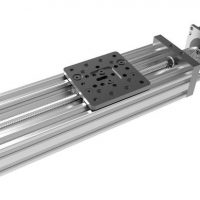When customers who search for the automation solutions decide to purchase the linear actuator mechanism in order to implement it for their purposes they mainly don’t even think about possible problems that preceded this technology creation. When best automation engineers want to make the proper linear actuator technology that would be convenient to use it for specific purposes and concrete environmental conditions, they start every linear actuator designing project from the stage of 3D modeling. let’s take a closer look at the 3D modeling stage and find out how graphics designers make the linear actuator modeling.
According to ProgressiveAutomations.com, first of all, 3D modeling is the process of using software to create a mathematical representation of a three-dimensional object or shape. The created object is called a 3D model. Such three-dimensional models are used in various industries, and engineering automation is definitely one of the most noticeable spheres where it plays an integral role. 3D modeling for electric linear actuators helps to avoid numerous mistakes at the planning stage when a linear actuator needs significant calculations that almost always depend on each other.
Computer-Aided Design Software for Actuators’ 3D Modeling and Reasons to Use It
Among the most frequently used software for engineering modeling are AutoCAD and Autodesk complex software that help engineers and designers visualize, make calculations and embody designing ideas even before creating their physical prototype. 3D design software in mechanical engineering is used in various fields, from industrial production and architecture to environmentally rational designing. In the case of electric linear actuators, the creation of 3D models makes great sense as manual calculations of all technical specifications of the electric actuator can turn into terrific nightmare. But the CAD software is able to make that fast and take into account physics as no human is able to. That is why it is so popular to create complicated industrial objects. Such a smart approach to actuators designing and modeling allows creating actuator solutions suitable for real-world demands and conditions. The list of 3D modeling advantages at the planning stage is fantastic, make sure yourself:
- Fast design with automated workflows;
- Maximizing CAD experience with special software;
- Shaping synchronized 2D and 3D project layouts;
- Save time with streamlined workflows;
- Accelerated design with Digital Component Library within the modeling software;
- Convenient search through the available stock of files, modification, and reuse of components early used and preserved;
- Possibility to store the frequently used enterprise components in the cloud;
- Exclusive software features unique for each 3d modeling software;
- Analysis of material flow directly in the modeling program;
- Optimization of equipment use and energy consumption.
How the Linear Actuator Creation Process Goes
Each linear actuator product begins with a concept that can be presented in the form of sketches, specifications or conditions that define the requirements for the project. Then the product designer or a group of designers and constructors takes this concept and turns it into a comprehensive product design using special engineering software. The final project must be technologically advanced and meet production requirements, for instance, withstand the specified loads and strains while minimizing the weight of the final product. At this stage, the project can be detailed and have several options. In addition, a linear actuator project modeling stage may be included using a testing and verification program for product designs before the final production phase.
How 3D Modeling Influences Linear Actuators Creation and Performance
The role of the precalculation stage embodied by the 3D modeling of the actuator should not be underestimated. The core idea of the creation of the 3D model of the object wanted later to become the working linear motion mechanism is that special software like AutoCAD or Autodesk are capable to calculate all actuators’ specifications and how they will influence the performance of the mechanism. This allows engineers to locate any possible weaknesses and eliminate them immediately before the production is started. Careful and attentive work with a 3D model of the linear actuator allows engineers to find out which parts of the mechanism should be modernized and what materials would be better to use in order to reach the highest possible effectiveness and integrity of the whole system and make it capable to resist the environmental conditions, where the mechanism is supposed to be placed after the creation. When smart-counted with the help of the above-mentioned software, electric linear actuators can serve during the pretty long period of time whereas demanding a little maintenance all along of its duty cycle.
3D modeling plays a huge role in the linear actuators’ creation process. Visualization of various objects and parts allows engineers to see in advance what exactly has not yet been done or not built and what can be improved. Thus, having seen the object in an understandable visual form, engineers can make the necessary decisions regarding the profitability of the actuator project and, if necessary, make adjustments. Such a computerized approach saves time and funds so that engineers don’t have to redo projects many times. It is much cheaper to initially create a 3D model of the actuator, evaluate it and subsequently correct all identified shortcomings. With such an approach linear actuator technologies can be modeled the way they will never make customers be disappointed.


